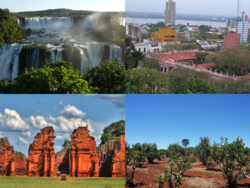Misiones Province
| Misiones | |||
|---|---|---|---|
| Province | |||

Clockwise from top: Iguazú Falls (Iguazú National Park), Posadas, Yerba Mate plantation, Guaraní Jesuit Mission of San Ignacio Miní.
|
|||
|
|||
| Anthem: Misionerita (The Song for the Child of Misiones) | |||
 Location of Misiones within Argentina |
|||
| Coordinates: 26°55′S 54°31′W / 26.92°S 54.52°WCoordinates: 26°55′S 54°31′W / 26.92°S 54.52°W | |||
| Country |
|
||
| Departments | 17 | ||
| Municipalities | 78 | ||
| Capital | Posadas | ||
| Government | |||
| • Governor | Hugo Passalacqua | ||
| • Deputies | 7 | ||
| • Senators | 3 | ||
| Area Ranked 21st |
|||
| • Total | 29,801 km2 (11,506 sq mi) | ||
| Population (2010) | |||
| • Total | 1,101,593 | ||
| • Rank | 9th | ||
| • Density | 37/km2 (96/sq mi) | ||
| Demonym(s) | misionero | ||
| Time zone | ART (UTC−3) | ||
| ISO 3166 code | AR-N | ||
| Website | www |
||
Misiones (Spanish pronunciation: [miˈsjones], Missions) is one of the 23 provinces of Argentina, located in the northeastern corner of the country in the Mesopotamia region. It is surrounded by Paraguay to the northwest, Brazil to the north, east and south, and Corrientes Province of Argentina to the southwest.
This was an early area of Roman Catholic missionary activity by the Society of Jesus in what was then called the Province of Paraguay, beginning in the early 17th century. In 1984 the ruins of four mission sites in Argentina were designated World Heritage Sites by UNESCO.
Indigenous peoples of various cultures lived in the area of the future province for thousands of years. At the time of European encounter, it was occupied by the Kaingang and Xokleng, later followed by the Guarani. The first European to visit the region, Sebastian Cabot, discovered Apipé Falls while navigating the Paraná River in December 1527. In 1541 Álvar Nuñez Cabeza de Vaca reached the Iguazú Falls.
In the 17th century, members of the Society of Jesus came to the region as missionaries. They began to establish a string of Jesuit Reductions, most notably that of San Ignacio. In a few years they set up 30 mission villages. They taught the Guarani western-style agriculture and crafts; the natives had subsisted in the jungle environment and suffered at the hands of European slave-drivers. Their crafts were sold and traded along the river and they shared in the Reductions' prosperity.
...
Wikipedia


